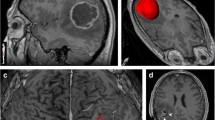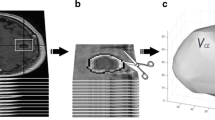Abstract
The potential impact of different radiological features of glioblastoma multiforme (GBM) on overall survival (OS) like tumor volume, peritumoral edema (PTE), necrosis volume, necrosis-tumor ratio (NTR) and edema-tumor ratio (ETR) is still very controversial. To determine the influence of volumetric data on OS und to compare different measuring techniques described in literature. We prospectively evaluated preoperative MR images from 30 patients harboring a primary supratentorial GBM. All patients received gross-total tumor resection followed by standard radiation and chemotherapy (temozolomide). By 3D semi-automated segmentation, we measured tumor volume, necrosis volume, PTE, postoperative residual tumor volume and calculated ETR, NTR and the extent of resection. After critical review of the existing literature we compared alternative measuring techniques with the gold standard of 3D segmentation. Statistical analysis showed a significant impact of the preoperative tumor and necrosis volumes on OS (p = 0.041, respectively p = 0.039). Furthermore, NTR also showed a significant association with OS (p = 0.005). Comparison of previously described measuring techniques and scorings with our results showed that no other technique is reliable and accurate enough as a predictive tool. The critical review of previously published studies revealed mainly inaccurate measurement techniques and patient selection as potential reasons for inconsistent results. Preoperatively measured necrosis volume and NTR are the most important radiological features of GBM with a strong influence on OS. No other measuring techniques are specific enough and comparable with 3D segmentation.

Similar content being viewed by others
References
Ostrom QT, Bauchet L, Davis FG et al (2014) The epidemiology of glioma in adults: a “state of the science” review. Neuro Oncol 16(7):896–913. doi:10.1093/neuonc/nou087
Stupp R, Hegi ME, Mason WP et al (2009) Effects of radiotherapy with concomitant and adjuvant temozolomide versus radiotherapy alone on survival in glioblastoma in a randomised phase III study: 5-year analysis of the EORTC-NCIC trial. Lancet Oncol 10(5):459–466. doi:10.1016/S1470-2045(09)70025-7
Weller M, van den Bent M, Hopkins K et al (2014) EANO guideline for the diagnosis and treatment of anaplastic gliomas and glioblastoma. Lancet Oncol 15(9):e395–e403. doi:10.1016/S1470-2045(14)70011-7
Lacroix M, Abi-Said D, Fourney DR et al (2001) A multivariate analysis of 416 patients with glioblastoma multiforme: prognosis, extent of resection, and survival. J Neurosurg 95(2):190–198. doi:10.3171/jns.2001.95.2.0190
Zinn PO, Mahajan B, Sathyan P et al (2011) Radiogenomic map** of edema/cellular invasion MRI-phenotypes in glioblastoma multiforme. PLoS ONE 6(10):e25451. doi:10.1371/journal.pone.0025451
Grabowski MM, Recinos PF, Nowacki AS et al (2014) Residual tumor volume versus extent of resection: predictors of survival after surgery for glioblastoma. J Neurosurg 121(5):1115–1123. doi:10.3171/2014.7.JNS132449
Stummer W, Pichlmeier U, Meinel T et al (2006) Fluorescence-guided surgery with 5-aminolevulinic acid for resection of malignant glioma: a randomised controlled multicentre phase III trial. Lancet Oncol 7(5):392–401. doi:10.1016/S1470-2045(06)70665-9
Li YM, Suki D, Hess K et al (2016) The influence of maximum safe resection of glioblastoma on survival in 1229 patients: can we do better than gross-total resection? J Neurosurg 124(4):977–988. doi:10.3171/2015.5.JNS142087
Reeves GI, Marks JE (1979) Prognostic significance of lesion size for glioblastoma multiforme. Radiology 132(2):469–471. doi:10.1148/132.2.469
Hammoud MA, Sawaya R, Shi W et al (1996) Prognostic significance of preoperative MRI scans in glioblastoma multiforme. J Neurooncol 27(1):65–73
Nestler U, Lutz K, Pichlmeier U et al (2015) Anatomic features of glioblastoma and their potential impact on survival. Acta Neurochir 157(2):179–186. doi:10.1007/s00701-014-2271-x
Xue D, Albright RE Jr (1999) Preoperative anaplastic glioma tumor volume effects on patient survival. J Surg Oncol 72(4):199–205
Pierallini A, Bonamini M, Osti MF et al (1996) Supratentorial glioblastoma: neuroradiological findings and survival after surgery and radiotherapy. Neuroradiology 38(Suppl 1):30
Gutman DA, Cooper LAD, Hwang SN et al (2013) MR imaging predictors of molecular profile and survival: multi-institutional study of the TCGA glioblastoma data set. Radiology 267(2):560–569. doi:10.1148/radiol.13120118
Wangaryattawanich P, Hatami M, Wang J et al (2015) Multicenter imaging outcomes study of the cancer genome atlas glioblastoma patient cohort: imaging predictors of overall and progression-free survival. Neuro Oncol 17(11):1525–1537. doi:10.1093/neuonc/nov117
Iliadis G, Kotoula V, Chatzisotiriou A et al (2012) Volumetric and MGMT parameters in glioblastoma patients: survival analysis. BMC Cancer 12:3. doi:10.1186/1471-2407-12-3
Crawford FW, Khayal IS, McGue C et al (2009) Relationship of pre-surgery metabolic and physiological MR imaging parameters to survival for patients with untreated GBM. J Neurooncol 91(3):337–351. doi:10.1007/s11060-008-9719-x
Ohgaki H, Kleihues P (2013) The definition of primary and secondary glioblastoma. Clin Cancer Res 19(4):764–772. doi:10.1158/1078-0432.CCR-12-3002
Mirimanoff R-O, Gorlia T, Mason W et al (2006) Radiotherapy and temozolomide for newly diagnosed glioblastoma: recursive partitioning analysis of the EORTC 26981/22981-NCIC CE3 phase III randomized trial. J Clin Oncol 24(16):2563–2569. doi:10.1200/JCO.2005.04.5963
Eads CA, Danenberg KD, Kawakami K et al (2000) MethyLight: a high-throughput assay to measure DNA methylation. Nucleic Acids Res 28(8):E32
Sawaya R, Hammoud M, Schoppa D et al (1998) Neurosurgical outcomes in a modern series of 400 craniotomies for treatment of parenchymal tumors. Neurosurgery 42(5):1044–1055 (discussion 1055-6)
Bland JM, Altman DG (1999) Measuring agreement in method comparison studies. Stat Methods Med Res 8(2):135–160
Cohen J (1968) Weighted kappa: nominal scale agreement with provision for scaled disagreement or partial credit. Psychol Bull 70(4):213–220
Charlson ME, Pompei P, Ales KL et al (1987) A new method of classifying prognostic comorbidity in longitudinal studies: development and validation. J Chronic Dis 40(5):373–383
Henker C, Kriesen T, Furst K et al (2016) Effect of 10 different polymorphisms on preoperative volumetric characteristics of glioblastoma multiforme. J Neurooncol 126(3):585–592. doi:10.1007/s11060-015-2005-9
Liu S-Y, Mei W-Z, Lin Z-X (2013) Pre-operative peritumoral edema and survival rate in glioblastoma multiforme. Onkologie 36(11):679–684. doi:10.1159/000355651
Schoenegger K, Oberndorfer S, Wuschitz B et al (2009) Peritumoral edema on MRI at initial diagnosis: an independent prognostic factor for glioblastoma? Eur J Neurol 16(7):874–878. doi:10.1111/j.1468-1331.2009.02613.x
Wu C-X, Lin G-S, Lin Z-X et al. (2015) Peritumoral edema on magnetic resonance imaging predicts a poor clinical outcome in malignant glioma. Oncol Lett 10(5):2769–2776. doi:10.3892/ol.2015.3639
Pope WB, Sayre J, Perlina A et al (2005) MR imaging correlates of survival in patients with high-grade gliomas. AJNR Am J Neuroradiol 26(10):2466–2474
Ramnarayan R, Dodd S, Das K et al (2007) Overall survival in patients with malignant glioma may be significantly longer with tumors located in deep grey matter. J Neurol Sci 260(1–2):49–56. doi:10.1016/j.jns.2007.04.003
Li W-B, Tang K, Chen Q et al. (2012) MRI manifestions correlate with survival of glioblastoma multiforme patients. Cancer Biol Med 9(2):120–123. doi:10.3969/j.issn.2095-3941.2012.02.007
Louis DN, Perry A, Reifenberger G et al (2016) The 2016 World Health Organization Classification of Tumors of the central nervous system: a summary. Acta Neuropathol 131(6):803–820. doi:10.1007/s00401-016-1545-1
Raza SM, Lang FF, Aggarwal BB et al (2002) Necrosis and glioblastoma: a friend or a foe? A review and a hypothesis. Neurosurgery 51(1):2–12 (discussion 12–3)
Ishii A, Kimura T, Sadahiro H et al (2016) Histological characterization of the tumorigenic “Peri-Necrotic Niche” harboring quiescent stem-like tumor cells in glioblastoma. PLoS ONE 11(1):e0147366. doi:10.1371/journal.pone.0147366
Fidoamore A, Cristiano L, Antonosante A et al. (2016) Glioblastoma stem cells microenvironment: the paracrine roles of the niche in drug and radioresistance. Stem Cells Int. doi:10.1155/2016/6809105
Chaichana KL, Cabrera-Aldana EE, Jusue-Torres I et al. (2014) When gross total resection of a glioblastoma is possible, how much resection should be achieved? World Neurosurg 82(1–2):e257–65. doi:10.1016/j.wneu.2014.01.019
Chen J, Li Y, Yu T-S et al (2012) A restricted cell population propagates glioblastoma growth after chemotherapy. Nature 488(7412):522–526. doi:10.1038/nature11287
Eidel O, Burth S, Neumann J-O et al (2017) Tumor infiltration in enhancing and non-enhancing parts of glioblastoma: a correlation with histopathology. PLoS ONE 12(1):e0169292. doi:10.1371/journal.pone.0169292
Odland A, Server A, Saxhaug C et al (2015) Volumetric glioma quantification: comparison of manual and semi-automatic tumor segmentation for the quantification of tumor growth. Acta Radiol 56(11):1396–1403. doi:10.1177/0284185114554822
Porz N, Habegger S, Meier R et al (2016) Fully automated enhanced tumor compartmentalization: man vs. machine reloaded. PLoS ONE 11(11):e0165302. doi:10.1371/journal.pone.0165302
Mazurowski MA, Desjardins A, Malof JM (2013) Imaging descriptors improve the predictive power of survival models for glioblastoma patients. Neuro Oncol 15(10):1389–1394. doi:10.1093/neuonc/nos335
Author information
Authors and Affiliations
Corresponding author
Ethics declarations
Conflict of interest
The authors have nothing to disclose and no conflicts of interest.
Electronic supplementary material
Below is the link to the electronic supplementary material.
Rights and permissions
About this article
Cite this article
Henker, C., Kriesen, T., Glass, Ä. et al. Volumetric quantification of glioblastoma: experiences with different measurement techniques and impact on survival. J Neurooncol 135, 391–402 (2017). https://doi.org/10.1007/s11060-017-2587-5
Received:
Accepted:
Published:
Issue Date:
DOI: https://doi.org/10.1007/s11060-017-2587-5




